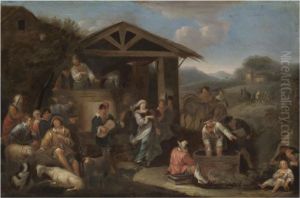Dirk Theodoor Helmbreker Paintings
Dirk Theodoor Helmbreker, sometimes also spelled Dirk or Dirck Helmbreeker, was a Dutch Golden Age painter born in Haarlem, the Netherlands. He was known for his Italianate landscapes and genre scenes influenced by his travels and stay in Italy. Helmbreker was part of a tradition of Dutch artists who left their homeland to seek inspiration and fortune in the sunny climes and classical ruins of Italy, which was then a central site for artistic training and experience.
Helmbreker's talent for art was recognized early on, and he became a student of the landscape painter Pieter de Molijn in Haarlem. This initial training would have provided him with a solid foundation in the Dutch landscape tradition, which he would later infuse with Italian influences. Seeking further artistic development and driven by the allure of Italy's history and landscape, Helmbreker made the significant decision to travel south.
In 1652, Helmbreker relocated to Rome, which was a hub for artists from across Europe. There, he joined the Bentvueghels, an association of mostly Dutch and Flemish artists working in Rome. The members of this group gave each other nicknames, and Helmbreker was known as 'Theodor of Harlem.' His works from this period reflect the impact of the Roman Campagna, the classical ruins, and the warm Mediterranean light on his painting style.
Helmbreker's paintings typically depict scenes of everyday life set against the backdrop of the Italian landscape, filled with ancient ruins and populated with local figures, including shepherds and peasants. He became proficient at integrating these human elements into his landscapes, a skill that made his work popular with patrons who sought to bring the essence of the Italian idyll into their homes.
He spent the majority of his career in Italy, where he built a modest but dedicated following. Helmbreker's works were collected by both Italian and Northern European patrons, and his influence can be seen in the works of later artists who also made the pilgrimage to Italy and absorbed the interplay of light, landscape, and antiquity that characterizes the Italianate genre.
Dirk Theodoor Helmbreker died in Rome in 1696, having spent over four decades in the country that so deeply influenced his art. His body of work remains as a testament to the fruitful exchange between Dutch artistic sensibilities and the Italian environment, and it continues to be studied as part of the broader narrative of the Dutch Golden Age and the enduring appeal of the Italianate aesthetic in European art.





